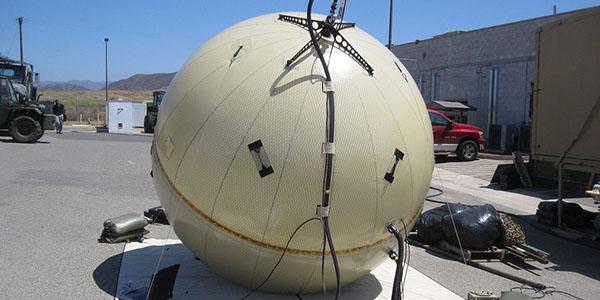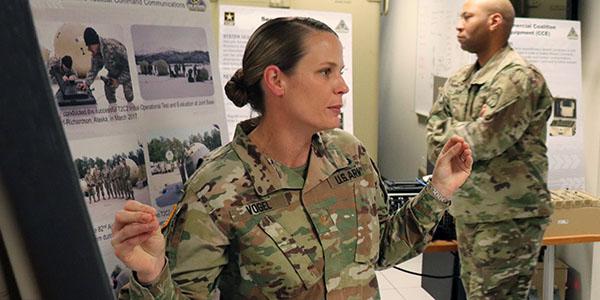U.S. Army Fields Inflatable Satellite Antenna
The U.S. Army is introducing a highly expeditionary communication solution to soldiers that will enable very large data file transmission, among other features, according to the Program Executive Office Command, Control and Communications-Tactical (PEO C3T), which leads the program of record for the technology.
The Transportable Tactical Command Communications satellite terminal capability, or the T2C2, will provide a vital link to the Army's tactical network for early entry forces. It will offer situational awareness and mission command capabilities to commanders conducting operations as well as for those setting the stage for follow-on forces, a PEO C3T spokesman states.
“We are the first boots on the ground for small teams setting up command post elements,” explained Maj. Jennifer Vogel, USA, assistant product manager for the T2C2, during SIGNAL Magazine’s recent visit to the PEO C3T at Aberdeen Proving Ground’s Command, Control, Communications, Computers, Intelligence, Surveillance and Reconnaissance (C4ISR) Center of Excellence. And given that “it works in the wind, in heat, humidity, snow and rain,” Maj. Vogel says, the high-bandwidth satellite terminals will be versatile.
Last week, the U.S. Defense Department announced a $522.5 million contract award to GATR Technologies, Huntsville, Alabama, a subsidiary of Cubic Corp., manufacturer of the inflatable satellite communications system. The award allows the Army to field multiple sizes of the T2C2 capability through 2023.
The contract is an extension of an existing Small Business Innovation Research (SBIR) program contract with GATR, the PEO C3T spokesman says. Although the contract ceiling is $522.5 million, the Army is not obligated to spend that amount, he notes. The contract supports “several Army formations, including Security Force Assistance Brigades, Expeditionary Signal Battalion Enhanced, and corps, division and brigade echelons,” the spokesman explains. In addition, the program supports joint warfighter efforts, including use by the U.S. Marine Corps.
Originally, GATR had developed the inflatable antenna system for use in space. The company's investment, along with two Defense Department SBIR contracts—one with the Army Space and Missile Defense Command (SMDC) and another with the Air Force Research Laboratory (AFRL)—funded the initial work that found the antenna system “to be even more useful in ground applications,” the company states. GATR claims it is the only company in the world producing the inflatable capability.
The Army will be using Lite and Heavy versions of the satellite terminals. The 1.2-meter T2C2 Lite operates in the X band, with a projected throughput of up to 4 megabits per second (Mbps) received and 3 Mbps transmitted, and three user access ports for each of the three enclaves. The 2.4-meter T2C2 Heavy, which uses the Ka band, has a throughput of up to 8 Mbps received and 8 transmitted. It offers 16 user access ports for each of four enclaves.
The PEO C3T is in the process of fielding the T2C2 capability to 10 units and will reach another 22 units in the next fiscal year, the spokesman says. “To date, units in the 82nd Airborne, 101st Airborne, 25th Infantry Division and 10th Mountain Division, among others, have been fielding the T2C2 capability,” he notes.
The T2C2’s inflatability is a key element of its design. It can provide a larger satellite antenna dish with increased capability and bandwidth efficiency in a smaller transport package, the PEO C3T spokesman states.
“Given that it is inflatable, it does pack down,” Maj. Vogel says, making the T2C2 air-droppable or transportable via commercial airlines. For initial operations, the T2C2 Lite packs into three soft cases for carry-on or into three hard-sided, airline-checkable transit cases. Meanwhile, the T2C2 Heavy fits into five hard-sided transit cases, approximately 164 pounds per case, which also are checkable, the major explains.
In addition, the Lite version of the inflatable satellite communications system does not require a signals background. “We are getting a lot of good feedback from the field, especially because the T2C2 Lite is geared toward the general purpose user,” Maj. Vogel notes. “Any MOS [military occupational specialty] is supposed to be able to set it up and operate it within 25 minutes or less. We’ve had a good success rate [with the initial fieldings].”
The T2C2 and other key mission command network technologies—such as the new small form factor Terrestrial Transmission Line of Sight radio, or TRILOS, also fielded with assistance from the PEO C3T’s Project Manager Tactical Network—support the Army’s need for high-speed, high-capacity voice, data and video communication capabilities worldwide.






Comments